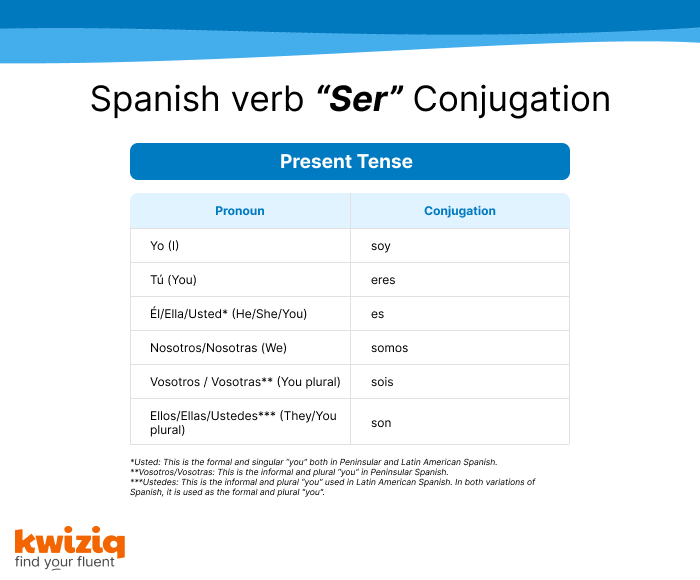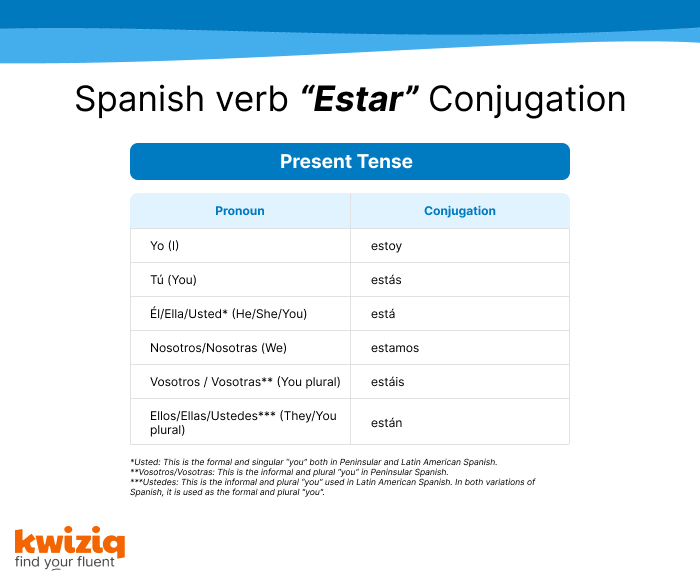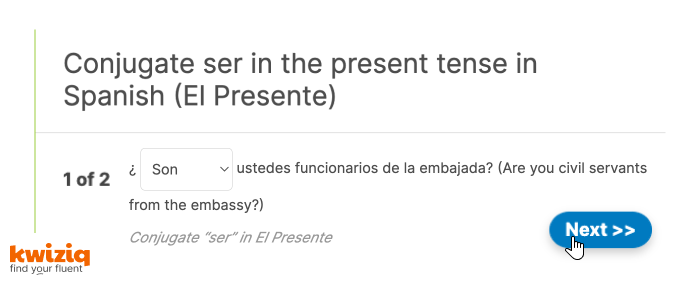Table of Contents
- When to Use "Ser"
- When to Use "Estar"
- How to Conjugate "Ser" in the Present Tense
- How to Conjugate "Estar" in the Present Tense
- "Ser" vs "Estar"
- 3 Ways to Practise Using the Spanish Verbs "Ser" and "Estar"
Now that you've mastered the basics of Spanish verb conjugation, concepts like Spanish infinitives, verb conjugation groups and verb conjugation tables have no more secrets for you, so it's time to focus your attention on the two most important verbs in the Spanish language: "ser" and "estar" (to be).
It may seem confusing to have two verbs that mean the same thing, but don't worry, we'll help you learn the difference between them, when to use each one and give you some lessons to practise the correct uses of "ser" and "estar".
The difference between the two verbs is that one is used for characteristics that we consider to be somehow inherent to something or someone, while the other is used to talk about qualities that are the result of an action. We'll go into more detail on when to use each verb, how to conjugate them, and share some examples of how to use them in a sentence.
Check out our guide to master more Spanish verb concepts (basic and advanced).
When to use "Ser"
The verb "ser" is generally used for qualities that, in the speaker's mind, are seen as inherent or intrinsic characteristics, without having any possible changes in mind. Those characteristics are part of the essence of that thing or person. By using "ser", we also express that things and people belong to a certain category or are of a certain type; we identify people and things.
For example, when we use adjectives that describe both personality and physical appearance, we use "ser". Look at the following examples:
Carlos es muy inteligente.
Carlos is very intelligent.
We consider that Carlos is inherently intelligent. His intelligence is part of who he is.
Carlos is tall and bold.
We consider these two physical characteristics, being tall and bold, as intrinsic characteristics of Carlos and put him in that category (of those who are tall and bold).
Carlos lives in Marbella, which is very pretty.
We describe Marbella with an adjective that is part of its essence.
The Spanish verb "ser" is used in a variety of other situations and contexts. The general use of "ser" as described earlier is very useful to know, but keep in mind that you will master this topic by learning the use of "ser" in specific contexts and situations.
Have a look at some lessons on the use of "ser" in different contexts:
- [ser] To talk about time, days, dates and seasons
- [ser] To say what you do for a living
- [ser] To identify things
- [ser] To express an essential or permanent characteristic
- [ser] To express origin or nationality
- [ser] To describe relationships
- [ser] To introduce people
- [ser] To say when/where something takes place
- [ser + para] To indicate a purpose
- [ser + para] To indicate a recipient
When to use "Estar"
The Spanish verb "estar" is used for qualities that, in the speaker's mind, have gone through a change or transformation. We consider these qualities as non-permanent conditions; they are seen as a result of that change at the moment of speaking.
For example, if you suddenly find your girlfriend very pretty (if she looks very pretty in a new dress or has just come back from the hairdresser's), you would use "estar":
Marina, you are [look] very pretty.
This expresses your personal or subjective impression on her looks at the moment of speaking.
If this person is describing their girlfriend to someone in a more objective way, just describing her inherent qualities, they would say:
My girlfriend Marina is pretty.
In this last example, by using "ser" instead of "estar", we're talking about a more objective description of Marina, not referring to a specific moment but to a general inherent characteristic of her (being a pretty person).
The idea of result and change is something very useful to connect to the verb "estar", but as with "ser", it is more practical to learn the different uses of "estar" by seeing the different contexts and situations, as not all of them are directly connected to this idea of change or transformation.
Have a look at some lessons on the use of "estar" in different contexts:
- [estar] To talk about locations
- [estar] To express a physical condition of something, someone or a place
- [estar] To describe feelings and emotions
- [estar + de] To describe a temporary job
- [estar + a] T o express fluctuating quantities and prices
How to Conjugate "Ser" in the Present Tense
"Ser" is an irregular verb in Spanish, meaning that it doesn't follow the rules of regular verbs. It's important to learn its conjugations as soon as possible, in the very first steps of your learning journey.
Here's a table that shows how to conjugate "ser" in the present tense:
Go to our lesson to see more detail about the conjugation of "ser" in the present tense and examples (with audio) and more detail.
How to Conjugate "Estar" in the Present Tense
"Estar" is also an irregular verb, which again means that it doesn't follow the rules of regular verbs. Additionally, it uses written accents in some of its forms. Learning and mastering its conjugation is another crucial step early on in the beginning stages of your learning process.
Here's a table that shows the present tense conjugations of "estar":
Go to our lesson to see more detail about the conjugations of "estar" in the present tense and examples (with audio) and more detail.
The present tense is simple enough to get started with, but you will need to learn how to conjugate "ser" and "estar" in every tense in Spanish.
"Ser" VS "Estar"
In very similar situations, we may use both "ser" and "estar". However, their use will have different meanings and nuances, so it's important to recognise when to use "ser" vs "estar".
Here are several instances of situations showing very similar examples but different meanings:
Describing someone's appearance or personality: "ser" or "estar"
Juan is very handsome and very friendly.
These are seen as essential characteristics of Juan, so we use "ser".
Juan is [appears to be] very handsome and very friendly today.
In this case, with "estar", Juan appears to be displaying these characteristics, possibly because he made an effort to look good and was in the mood to be extremely friendly today. We see this as something that was in evidence at the time we saw Juan, rather than as one of his usual or essential characteristics.
Saying what you do or where you work: "ser" or "estar"
Juan is a waiter.
This is Juan's profession. We are describing what he does for a living, so we use "ser".
Juan is [working as] a waiter at his brother's restaurant.
In this case, with estar (+ de), we are not necessarily saying what Juan does for a living; we use "estar" when we talk about working temporarily at a place. He may just be working at the restaurant for the summer, for example.
Talking about food quality: "ser" or "estar"
Carmen's chicken rice is delicious.
This is expressing the always delicious quality of the dish, so we use "ser".
Carmen's chicken rice is [tastes] delicious.
In this case, with "estar", the quality of the dish is good, but what we're really expressing here is our opinion of the dish after tasting it and having had the experience this time.
Remember that both Spanish verbs "ser" and "estar" mean "to be", so you just need to be careful with what you really want to convey to use one or the other.
3 Ways to Practise How to Use the Spanish Verbs "Ser" and "Estar"
Now that you've unlocked the knowledge of the main Spanish verbs, "ser" and "estar", the best way to continue your Spanish learning is by applying what you've learned and practise, practise, practise!
1. Start with our lessons focused on "ser" and "estar"
At Progress with Lawless Spanish, we have hundreds of Spanish lessons for you to progress faster in your learning journey, and many are dedicated specifically to learning how to use the most important Spanish verbs, "ser" and "estar".
In each lesson, you'll get a brief explanation on how to use "ser" and "estar" correctly, partnered with useful examples and audio files to practise your listening and speaking skills while you're at it. You'll also be able to practise what you've learnt straight away with our very special (and user favourite!) microkwizzes, which are quick and simple 2-question kwizzes to test your understanding of that specific lesson.
2. Test your progress with Spanish fill-in-the-blanks exercises
If you want to test your knowledge, try out our fill-in-the-blanks exercises.
These tests allow you to apply your knowledge in a more authentic way, as you are required to use your understanding of the language to figure out whether to use "ser" or "estar" to complete the test. This helps you develop your skills in a more meaningful way, and it can be more rewarding to see your progress.
Plus, the tests are automatically graded, so you get immediate feedback on your performance. Genial, ¿no crees?
Here is a list of some of our interactive fill-in-the-blanks exercises to help you practise the various uses of the versatile Spanish verbs "ser" and "estar":
- El Día del Padre (ser or estar) - A2 level
- Comida afrodisiaca (ser or estar) - A2 level
- En la fiesta de Javier (ser orestar) - B1 level
- Mi padre (ser orestar) - B2 level
3. Improve your skills with our exercises focused on using "ser" or "estar"
We also have exercises for you to practise your reading, writing, and listening skills.
Here are two exercises that include some focused practice on the correct use of "ser" and "estar", where you'll have the opportunity to see these verbs used in specific contexts.
- Writing exercise: A perfect day in Granada (A1 level)
- Reading exercise: De mochilero por Perú pt.1 (A2 level)
At Progress with Lawless Spanish, we have many resources to help you apply what you've learned today with hands-on practice so you can become a fluent Spanish speaker.
Start here to create your free account!
With your personalised study plan, interactive exercises, and uniquely efficient kwizzes, you'll get targeted practice and be able to track your progress over time. And, with access to our verb tables and lessons, you'll have everything you need to master the Spanish verbs "ser" and "estar".
So why wait? It's time to take your first step towards fluency in Spanish!



